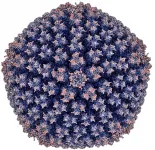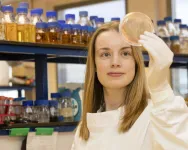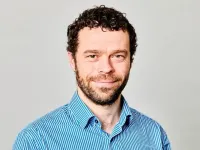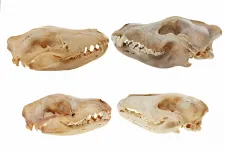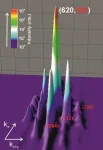(Press-News.org) Russian researchers have proposed a new method for synthesizing high-quality graphene nanoribbons -- a material with potential for applications in flexible electronics, solar cells, LEDs, lasers, and more. Presented in The Journal of Physical Chemistry C, the original approach to chemical vapor deposition, offers a higher yield at a lower cost, compared with the currently used nanoribbon self-assembly on noble metal substrates.
Silicon-based electronics are steadily approaching their limits, and one wonders which material could give our devices the next big push. Graphene, the 2D sheet of carbon atoms, comes to mind but for all its celebrated electronic properties, it does not have what it takes: Unlike silicon, graphene does not have the ability to switch between a conductive and a nonconductive state. This defining characteristic of semiconductors like silicon is crucial for creating transistors, which underlie all of electronics.
However, once you cut graphene into narrow ribbons, they gain semiconducting properties, provided that the edges have the right geometry and there are no structural defects. Such nanoribbons have already been used in experimental transistors with reasonably good characteristics, and the material's elasticity means the devices can be made flexible. While it is technologically challenging to integrate 2D materials with 3D electronics, there are no fundamental reasons why nanoribbons could not replace silicon.
A more practical way to obtain graphene nanoribbons is not by cutting up graphene sheets or nanotubes but the other way around, by growing the material atom by atom. This approach is known as bottom-up synthesis, and unlike its top-down counterpart, it yields structurally perfect, and therefore technologically useful, nanoribbons. The currently dominant method for bottom-up synthesis, known as self-assembly, is costly and difficult to scale up for industrial production, so materials scientists are seeking alternatives to it.
"Graphene nanoribbons are a material whose properties are of interest to fundamental science and hold a promise for applications in all sorts of futuristic devices. However, the standard technique for its synthesis has some drawbacks," explained Pavel Fedotov, a senior researcher at the MIPT Laboratory of Nanocarbon Materials. "Maintaining ultrahigh vacuum and using a gold substrate is very costly, and the output of material is comparatively low."
"My colleagues and I have proposed an alternative way to synthesize atomically flawless nanoribbons. Not only does it work under normal vacuum and with the much cheaper nickel substrate, the yield increases by virtue of the nanoribbons being produced as multilayer films, rather than individually. To separate these films into monolayer ribbons, they are put in suspension," the researcher went on. "Importantly, none of that compromises the quality of the material. We confirmed the absence of defects by obtaining the appropriate Raman scattering profiles and observing photoluminescence of our nanoribbons."
Graphene nanoribbons come in different types, and the ones that the Russian scientists manufactured using their original chemical vapor deposition technique have the structure depicted on the right in Figure 1. They are seven atoms wide and have edges someone found reminiscent of an armchair, hence the name: 7-A graphene nanoribbons. This type of nanoribbons has the semiconducting properties valuable for electronics, unlike its 7-Z cousin with zigzag edges (shown on the left), which behaves like a metal.
The synthesis occurs in an airtight glass tube evacuated to one-millionth the standard atmospheric pressure, which is still 10,000 times higher than the ultrahigh vacuum normally required for nanoribbon self-assembly. The initial reagent used is a solid substance containing carbon, hydrogen, and bromine and known as DBBA. It is placed in the tube with a nickel foil, pre-annealed at 1,000 degrees Celsius to remove oxide film. The glass tube with DBBA is then subjected to heat treatment for several hours in two stages: first at 190 C, then at 380 C. The first heating leads to the formation of long polymer molecules, and during the second stage, they transform into nanoribbons with atomically precise structure, densely packed into films that are up to 1,000 nanometers thick.
After obtaining the films, the researchers suspended them in a solution and exposed them to ultrasound, breaking up the multilayer "stacks" into one-atom-thick carbon nanoribbons. The solvents used were chlorobenzene and toluene. Prior experiments showed these chemicals to be optimal for suspending nanoribbons in a stable manner, preventing aggregation back into stacks and the appearance of structural defects. Nanoribbon quality control was also done in suspension, via optical methods: The analysis of Raman scattering and photoluminescence data confirmed that the material had no significant defects.
Because the new synthesis technology for manufacturing defectless multilayer 7-A carbon nanoribbons is comparatively cheap and easy to scale up, it is an important step toward introducing that material into the large-scale production of electronic and optical devices that would eventually vastly outperform the ones existing today.
"Experience shows that once a new carbon material is discovered, that means new properties and new applications. And graphene nanoribbons were no different," the head of the MIPT Laboratory of Nanocarbon Materials, Elena Obraztsova recalled. "Initially, nanoribbons were synthesized inside single-walled carbon nanotubes, which served to constrain ribbon width. It was on these embedded nanoribbons that luminescence was originally demonstrated, with its parameters varying with nanotube geometry."
"Our new approach -- bottom-up chemical vapor deposition -- enables ultranarrow graphene ribbons to be produced in large amounts and under fairly mild conditions: moderate vacuum, nickel substrate. The resulting material exhibits bright excitonic photoluminescence. It is promising for many applications in nonlinear optics, which we are going to pursue," the researcher added.
INFORMATION:
The study reported in this story featured researchers from MIPT, Prokhorov General Physics Institute and the Institute of Bioorganic Chemistry of the Russian Academy of Sciences, the Russian Quantum Center, Skoltech. That research was supported by the Russian Foundation for Basic Science grant Nos. 19-32-60006 and 18-29-19113_mk.
The Laboratory of Nanocarbon Materials was established at MIPT in 2018 under Project 5-100, basing on the Laboratory for Nanomaterial Spectroscopy of Prokhorov General Physics Institute. Headed by Elena Obraztsova, the MIPT laboratory focuses on low-dimensional carbon material synthesis, research, and applications. Besides the more familiar graphene and single-walled carbon nanotubes, the lab investigates new modifications of these materials: doped graphene, graphene nanoribbons, as well as nanotubes filled with donor and acceptor inclusions. The team of the laboratory has worked out and published recommendations on the application of nanomaterials as saturable absorbers in laser physics, conductive transparent electrodes in optoelectronics, as well as in plasmonic terahertz interferometry.
CHICAGO (January 11, 2021): A new study of liver transplant centers confirms that non-Hispanic white patients get placed on liver transplant waitlists at disproportionately higher rates than non-Hispanic Black patients. However, researchers went a step further as they identified key reasons for that disparity: disproportionate access to private health insurance, travel distance to transplant centers, and a potential lack of knowledge among both practitioners and patients about available options. The study was selected for the 2020 Southern Surgical Association Program and published as an "article in press" on the website of the Journal of the American College of Surgeons in advance of print.
"We found that the Black population was underrepresented at the vast majority of centers, ...
All-solid-state batteries are the next-generation batteries that can simultaneously improve the stability and capacity of existing lithium batteries. The use of non-flammable solid cathodes and electrolytes in such batteries considerably reduces the risk of exploding or catching fire under high temperatures or external impact and facilitates high energy density, which is twice that of lithium batteries. All-solid-state batteries are expected to become a game changer in the electric vehicle and energy storage device markets. Despite these advantages, the low ionic conductivity of solid electrolytes combined with their high interfacial resistance and rapid deterioration reduce battery performance and life, thus limiting their commercialization.
The ...
Special Issue: Tumor Microenvironment and Drug Delivery
Guest Editors: Huile Gao, West China School of Pharmacy, Sichuan University, Chengdu, China; Zhiqing Pang, Fudan University, Shanghai, China and Wei He, China Pharmaceutical University, Nanjing, China
The Journal of the Institute of Materia Medica, the Chinese Academy of Medical Sciences and the Chinese Pharmaceutical Association, Acta Pharmaceutica Sinica B (APSB) is a monthly journal, in English, which publishes significant original research articles, rapid communications and high quality reviews of recent advances in all areas of pharmaceutical sciences -- including pharmacology, pharmaceutics, medicinal chemistry, natural products, ...
The Journal of the Institute of Materia Medica, the Chinese Academy of Medical Sciences and the Chinese Pharmaceutical Association, Acta Pharmaceutica Sinica B (APSB) is a monthly journal, in English, which publishes significant original research articles, rapid communications and high quality reviews of recent advances in all areas of pharmaceutical sciences -- including pharmacology, pharmaceutics, medicinal chemistry, natural products, pharmacognosy, pharmaceutical analysis and pharmacokinetics.
Featured papers in this issue are:
Berberine diminishes cancer cell PD-L1 expression and facilitates antitumor immunity via inhibiting the deubiquitination activity of CSN5 by authors Yang Liu, Xiaojia Liu, Na Zhang, Mingxiao Yin, Jingwen Dong, Qingxuan ...
"The findings provide an increased understanding of how the virus gets through the stomach and intestinal system. Continued research can provide answers to whether this property can also be used to create vaccines that ride 'free rides' and thus be given in edible form instead of as syringes," says Lars-Anders Carlson, researcher at Umeå University.
The virus that the researchers have studied is a so-called enteric adenovirus. It has recently been clarified that enteric adenoviruses are one of the most important factors behind diarrhea among infants, and they are estimated to kill more than 50,000 children under the age of five each year, ...
Researchers from Trinity College Dublin have discovered a key mechanism underlying bacterial skin colonisation in atopic dermatitis, which affects millions around the globe.
Atopic dermatitis (AD, also called commonly eczema) is the most common chronic inflammatory skin disorder in children, affecting 15-20% of people in childhood. During disease flares, patients experience painful inflamed skin lesions accompanied by intense itch and recurrent skin infection.
The bacterium Staphylococcus aureus (S. aureus) thrives on skin affected by AD, increasing inflammation and worsening AD symptoms. Although a small number of therapies are available at present for patients with moderate ...
Leading research at Newcastle University has been used to shape how dentistry can be carried out safely during the Covid-19 pandemic by mitigating the risks of dental aerosols.
It is well known that coronavirus can spread in airborne particles, moving around rooms to infect people, and this has been a major consideration when looking into patient and clinician safety.
Research, published in the Journal of Dentistry, has led the way in helping shape national clinical guidance for the profession to work effectively under extremely challenging circumstances.
The findings have been used by the Dental Schools' Council, Association of Dental Hospitals and the Scottish Dental Clinical Effectiveness ...
Micro-CT scanning and digital reconstructions have been used to compare the skulls of the Tasmanian tiger (thylacine) and wolf across their early development and into adulthood, establishing that not only did the thylacine resemble the wolf as adults, but also as newborns and juveniles.
"Remarkably, the Tasmanian tiger pups were more similar to wolf pups than to other closely related marsupials," Professor Andrew Pask from the University of Melbourne said.
The collaborative study with Flinders University and Museums Victoria complement earlier findings that thylacine and wolf have evolved ...
Artificial intelligence and machine learning are already an integral part of our everyday lives online. For example, search engines such as Google use intelligent ranking algorithms and video streaming services such as Netflix use machine learning to personalize movie recommendations.
As the demands for AI online continue to grow, so does the need to speed up AI performance and find ways to reduce its energy consumption.
Now a University of Washington-led team has come up with a system that could help: an optical computing core prototype that uses phase-change material. This system is fast, energy efficient and capable of accelerating ...
Topological materials are characterised by unique electronic and physical properties that are determined by the underlying topology of their electronic systems. Scientists from the Max Planck Institutes for Microstructure Physics (Halle) and for Chemical Physics of Solids (Dresden) have now discovered that (TaSe4)2I is the first material in which a charge density wave induces a phase transition between the semimetal to insulator state.
An international team of scientists at the Max Planck Institute for Microstructure Physics, Halle (Saale), the Max Planck Institute for Chemical Physics of Solids ...




